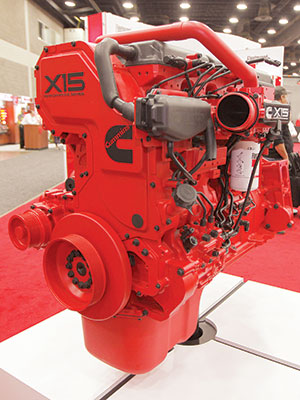Senior Reporter
Cummins to Offer Option of Electric Engines by 2019
This story appears in the June 26 & July 3 print edition of Transport Topics.
Cummins Inc. will have a fully electrified powertrain system available for commercial customers by 2019 and a range-extended electric truck ready in 2020, and is developing its next-generation heavy-duty diesel engine, the Columbus, Ind.-based company said.
Cummins, which prefers to be known for power technology, is at a “critical juncture,” Chairman and CEO Tom Linebarger said. Rather than waiting to be disrupted by change, Cummins “is looking for ways to disrupt ourselves,” Linebarger said.

“There is a lot happening in our markets technically. We are really ex- cited about the technology changes and what we think we can do with those technologies to serve our customers better,” Linebarger said.
PHOTO: A Cummins X15 truck engine at the 2017 Mid-America Trucking Show. Its next-generation X15 will be smaller and lighter. (John Sommers II for Transport Topics)
Cummins sees electrification coming to all its markets, said Julie Furber, executive director of electrification business development.
“We believe we know some things about electrification that maybe others don’t,” she said.
Among the first commercial truck markets Cummins sees as ready for electrification are those involved in urban pickup-and-delivery operations, Furber said.
“These customers already use Cummins engines in their equipment and have come to rely on us to provide high-performing and dependable products even in some of the most demanding applications and value our network of service and support,” she said.
The falling price of commercial batteries paired with increasingly stringent noise and emissions regulations are clearing the path for widespread adoption of vehicle electrification, Cummins said.
At the same time, automaker Tesla is developing an electric Class 8 longhaul truck, which the manufacturer plans to unveil in September.
Analysts agreed Cummins is prepared for that competition.
The company’s announcement of plans for electrification of powertrains in 2019 and 2020 is “a big deal” that shows Cummins is “further along than was previously known in addressing what is likely its single- biggest long-term risk: that electric will replace diesel as the dominant fuel source for commercial vehicle powertrains,” Stifel, Nicolaus & Co. analyst Michael Buadendistel wrote in a note to investors.
He added, “We believe that Cummins aspires to be the leader in all of the potential engine technologies to become as agnostic as possible with regard to the industry’s fuel of choice years from now.”
Cummins will continue to use acquisitions, joint ventures and organic growth to meet its goals, Credit Suisse analyst Jamie Cook said in an investors note.
“CMI has a strong history of evolving and being ahead of the curve as technologies change and a good understanding of its customers, especially what they want and when they want it,” she wrote.
For instance, Cummins now offers its own electronic logging device for commercial truck drivers to track hours of service. The software works with smartphones. The app is aimed at the small- and medium- size fleets that don’t have a lot of money to spend on telematics, and was developed by its newly launched Zed Connect company, according to the manufacturer.
Meanwhile, Cummins is working on its next-generation heavy-duty engine, which will be designed to offer improved power and efficiency for even more aerodynamically designed trucks — conventional and cabover — that it expects are coming in the future, Chief Technical Officer Jennifer Rumsey said.
She added that engine will come in a “pack- age that is smaller and lighter than our X15 [engine, in full production since January].”
Also, the company said its latest aftertreatment system for diesel engines is 60% smaller and 40% lighter than previous systems.
“We have expanded the systems beyond diesel already, including to natural gas,” Rumsey added.
“Our partners know Cummins delivers; we don’t overpromise,” Rumsey said.
Later, she added the company is looking at “technologies we can’t even talk about yet.”




